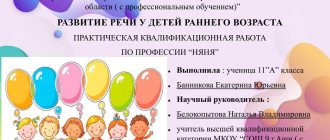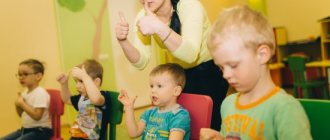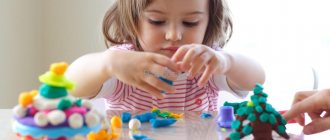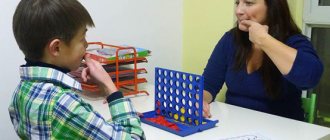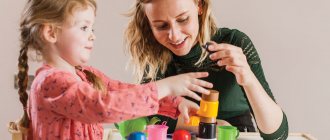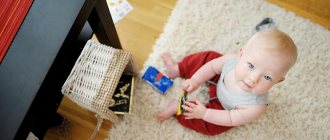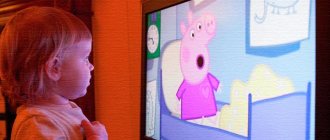Good afternoon, dear blog readers!
With what trepidation we await the first words from our cub! When “aha” time fades into the background, the long-awaited “mom” comes first. Then the vocabulary is replenished with awkward “dyay”, “udi”, etc. During this period, violations are not visible if the baby increases the number of spoken words every month. And by the age of 3, they can be easily noticed if you constantly work with your baby. But this is what a toddler should be able to do at this age, how to identify pathologies, and this is what I want to tell you this time. I will also recommend some effective lessons.
Features of the speech apparatus at 3 - 4 years
Speech therapy classes with children 3 to 4 years old are used quite often. It’s just that pathologies are usually not detected until this time. My first-born is now 4.5 years old, we are actively attending a speech therapist and general developmental courses. In addition, I do not push back the role of kindergarten in the formation of sound pronunciation. In a year (from 3 years old) a little person is able to master a lot.
The vocabulary at this point is 1500 words, sometimes more. But still, a tiny child at this age is unable to correctly compose a story and confuses the endings. And there may be problems with the pronunciation of some sounds or letters. Who doesn't know the insidious "R" or "L"? But this does not mean underdevelopment, because everything should happen gradually. There is no need to look away either. The baby needs help to overcome such a difficult milestone. And in order to see the shortcomings, let’s figure out what a child of 3–4 years old should be able to do.
What activities can be done with your child at home for speech development?
It's no secret that children spend most of their time at home.
Note! Therefore, it is so important to properly organize the baby’s activities aimed at developing children’s speech.
Articulation gymnastics and pronunciation training
Basically, all speech therapy classes for children 3-4 years old begin with small gymnastics for the organs of articulation. Most popular:
- Smile - stretch your lips in a smile, showing your teeth (the same without teeth).
- Dudochka - fold your lips into a tube and stretch them forward.
- Balloon - inflate your cheeks and hold the air for 3-5 seconds.
- Shoulder blade - place your tongue outstretched on the lower lip and fix it.
- Needle - tighten the tongue very much, make it as thin as possible and pull it forward, fix it.
- Jam - lick your upper and lower lips with your tongue.
- Let's brush our teeth - run your tongue over the upper teeth, then over the lower ones.
- Hill - the tongue rests on the lower teeth, while the middle of it tends to the palate, forming a hill. With this training, the child remembers the position of the tongue used to pronounce many sounds.
Games for hearing development
Children of primary preschool age are offered games to distinguish the volume of a sound or recognize an object that makes a sound. For many speech therapy tasks offered to children 3-4 years old, musical instruments such as pipes, drums, and piano are used.
Also at this age it is already possible to teach a child to distinguish sounds by ear. This can be done by offering a game: “Clap your hands when you hear the song of the water (sound “S”): sleep, frame, braid, mom, Sasha, etc.”
How to properly give speech therapy massage to a child at home
Important! It is best to call sounds by special “names”: the sound “S” is the song of the water, the sound “Sh” is the hiss of a snake, etc. It will be easier for the child to remember and orientate himself. When pronouncing a word in which the baby must highlight the sound, it should be exaggerated.
Finger gymnastics
This gymnastics is used as an activity for the development of speech for 4 years at home and in preschool educational institutions. By this age, the baby understands simple instructions and is able to follow them, and children's fine motor skills are already sufficiently developed to make small “compositions” from their fingers. Here are some of them:
- Lock - hands are tightly clasped in a lock, with the fingers of both hands intertwined with each other.
- Scratching - alternately depict “paws” with your right and left hands.
- Let's warm up our hands by rubbing our left palm vigorously with our right palm.
- Glasses - make a circle with the thumb and index finger of each hand and bring it to your eyes - put on glasses.
Finger gymnastics develops speech
Poetry learning, reading and storytelling
Children 3-4 years old often learn poetry, retell fairy tales, and learn to read during speech therapy sessions at home. This is facilitated by numerous manuals and workbooks for younger preschoolers, which can be purchased at any children's store or printed from the Internet.
The best authors of children's fiction: Korney Chukovsky, Alexander Pushkin, Agnia Barto, Samuil Marshak. The main task of memorizing short poems and retellings of works is to enrich the child’s vocabulary, expand his fantasy and imagination.
Note! In 2021, Bardysheva T.Yu. and Monosova E.N. published a special manual aimed at the comprehensive speech development of children of primary preschool age. The notebook by Monosova and Bardysheva consists of 120 pages of high-quality exercises and games that help increase the child’s active and passive vocabulary, develop phonemic awareness and coherent speech, and improve the processes of thinking, attention and memory. This manual was created both for professional speech therapists and defectologists, and for parents - it is written in simple and understandable language.
Talker Skills
Let's start with the speech. At 3 years old we were already actively babbling. My surprise was when I was reading a long verse, and my son suddenly began to pronounce it ahead of me! Now I don’t remember exactly, something like: “... a mouse, a little mouse, a bunny, a squirrel, a frog, a caterpillar, a midge, a fly, a mole, a magpie - a rattler...”. And he already remembered all this guard. Their memory is not yet clogged with anything; children are able to memorize short poems, short stories and fairy tales at this time. Speak texts of several sentences. It may be clumsy, but it trains your memory!
And in mathematics they also know numbers up to five - this is the minimum! They are able to count objects, some children even do it in reverse order. Of course, addition and subtraction are still a long way off. But even a simple score is an achievement if you take classes with your family. You know, the child’s skills are more likely to be assessed by the family. How does he know the numbers himself? And also, the concepts of long - short, wide - narrow, hard - soft. Although, by the age of 4, the baby learns softness on his own, with bruises and bumps... And his relatives should verbalize it to him, right?
In addition, a fidget can decorate simple objects more or less neatly. These are drawn balls. What about getting to know geometric objects? The kids also remember it with a bang. The most basic ones: circle, square, triangle, rectangle. From the age of 3 they can even imitate. And, of course, colors and body parts. It is necessary. Therefore, if your little one is verbose, confusing the endings, it’s not a problem. But if a little person is not able to remember simple things for his age, this is a reason to turn to a specialist.
How to determine speech delay
You can independently diagnose the verbal skills of your 3-year-old child. Here are the characteristic features that should alert you. Pay attention to them. Like a child speaks. Too quickly (“chokes”) or drawls out words. The endings are blurred, illegible, or “swallowed.” Speaks in snatches from books or cartoons or repeats what adults have said. There are no own phrases. For suggestions. Does not use subject, predicate or object. Speaks individual syllables, shortens words. Doesn't speak whole words. To understand the appeal. A 4-year-old child does not comply with requests or basic commands. On a psycho-emotional background. Children are restless, anxious, have increased salivation, and even in a calm state sway from side to side. On communication skills. The baby does not play with other children and plays with toys incorrectly. For example, instead of feeding a doll from a plate, he puts it on a plate. If by some criteria you recognize your situation, consult a neurologist or speech therapist. Or try to “catch up” with your peers on your own.
Tests to determine pathologies
Doctors tirelessly repeat that each child is individual. And if the child does not speak many words until closer to two years, this is not a reason to worry. Of course, you can’t help but compare with those who are already mumbling with all their might at the age of 2. But for what?
I'll answer to worry. You just need to set the maximum possible boundaries when the little one starts doing something new. As for speech impairment, perhaps, if before the age of 3 a child does not connect 2 words, this is a reason to worry. But along with this, you should notice other shortcomings. Does he respond to his name, pay attention to new toys, how does he interact with other children? Let's go through the list a little:
- Ask them to draw a circle on a piece of paper. By the age of 4, he should be able to draw something similar to this geometric figure. If this doesn’t work out or he doesn’t understand what they want from him, this is a reason to worry.
- Pay attention to whether the baby can climb steps. The baby must be able to climb up and down.
- Can you assemble a turret at least from simple cubes?
- Having passed the three-year mark, the little one must communicate in at least short phrases. For example: “Mom, let's go!” Of course, there are kids who are already building sentences. But the minimum that he should be able to do is pronounce the simplest phrases.
- Not interested in new games when you offer to participate.
Prices and duration of treatment
One lesson with a speech therapist or speech pathologist for a three-year-old child cannot last more than 45 minutes, since the baby is not yet ready to concentrate and maintain attention for a long time. The lesson usually takes place in the presence of parents, which allows you to create a comfortable atmosphere for the baby. The number of correctional classes is determined individually for each young patient, however, experts assure that if after 2-3 months of regular visits to a specialist, parents do not notice a noticeable improvement in the child’s speech skills, they should think about choosing another speech pathologist.
Consultation with a speech therapist - defectologist, initial appointment with detailed diagnostics (40 minutes - 1 hour) - 1800 rubles.
Repeated appointment, lesson (40 min - 1 hour) - 1500 rubles.
Speech therapy massage - 1500 rubles/session.
Probe massage - 1500 rubles/session.
Causes of pathologies
You know, talking with a speech therapist, I learned that in recent years the services of a specialist have become more in demand. And the problem is not only in diseases, but also in education. The tiny creature understands phones and computers better than adults, even at 3 years old. Have you noticed? Well, at the age of 5, he generally becomes a child prodigy! With these talents, what is there to talk about...
How do the kids spend their time? Basically, they already have the knowledge of how to turn on the TV and approach their parents’ laptops. This is a new generation that moves with the times. Sadly. So we generally run the risk of losing the gift of sound pronunciation, if we think about it. But for the baby to develop normally, you just need to talk to him. Read, talk about what you observe. Don't walk in silence. Answer questions... After all, this is how we grew up.
The godfather gave the daughter of one of my friends a real phone for her 3rd birthday. Of course, restless people should not lag behind progress. But her mother gives her this phone for special merits. And for a short time. It’s better to let the child’s brain be interested in the designers, that’s how she motivates.
Read more about speech therapy classes for children aged 5 - 7 years.
These are acquired reasons. They can be prevented, what do you think? But there are also congenital ones. This requires painstaking work. Be aware that delays will result from:
- increased or decreased tone
- asphyxia at birth
- oxygen deprivation in the womb
- congenital abnormalities in the formation of the jaw or tongue frenulum
If these symptoms are detected at birth, rush to the neurologist (at the last point the dentist determines the cause)! This can be cured in 90% of cases within a year. Then there will probably be no consequences.
Types of pathologies
From birth, the baby should be shown to a neurologist. Even if the pediatrician is silent about it, lead the way yourself. A large percentage of children now need consultations and corrections in neurology. If the cause of the defects is congenital, the specialist will give instructions that must be strictly followed.
But if a child does not speak at 3-4 years of age, it may be a general underdevelopment of speech (GSD). What diseases can be identified?
- Dysarthria is insufficient functioning of the nerve endings that provide communication between the cerebral cortex and the speech center.
- Aphonia - the child speaks, but sound pronunciation is impaired.
- Stuttering is also poor sound reproduction, or more precisely, the pace of conversation. This is due to spasms of the speech muscles.
We had one teacher who said strange phrases “nysh-nysh”. He inserted this in the most unexpected places in his lectures. So, it turns out that stuttering could be treated this way in the past. The man stopped drawing out words, but instead inserted similar words into his stories.
- Dysphasia is a disorder caused by poor hearing.
- Aphasia is a partial (possibly complete) loss of speech caused by disorders of the central nervous system.
- Alalia is a lesion of the cerebral cortex, while the sound apparatus is underdeveloped.
I have highlighted the most important points. A good doctor will be able to tell you about this in detail. And we’ll talk about exercises to improve the quality of speaking function.
Practical lessons for better pronunciation
As I already said, at the age of 3-4 years there comes a time when the help of a specialist is needed. In the kindergarten where I take Dominic, classes are held with children (individual and frontal).
We also visited a speech therapist separately from August to October. But Dominic could only stand it for 20 minutes, and sometimes less. After the change of specialist, my son began to be interested in the lessons. Shifts have appeared. I say this to ensure that little brats should not take this as an intrusive procedure. The doctor should play with them! Or rather, the baby should think so.
And now I want to talk about individual and frontal types.
- Individual
When the baby sits only with the teacher, the effectiveness is much better. Attention is paid to him alone. By playing special games aimed at correcting the deviations of a particular person, the doctor achieves results. This also includes exercises for the tongue, humming various songs. Have you noticed singers who sing on stage but speak with a stutter? If you start practicing, the shortcomings can be corrected.
- Frontal
Otherwise called group. Lessons of this type are conducted for children in the same situations. This may be a hearing impairment, an inability to distinguish paired sounds, or other conversational aspects. Usually the group consists of 6 - 8 people, the teacher selects special exercises aimed at expanding vocabulary and eliminating the root cause.
And it is not necessary to send the baby to a specialized kindergarten. There are such circles in almost all state institutions.
We help at home
My son and I enjoy practicing at home. We do everything that the speech therapist recommends in a playful way. One of the most common defects is the incorrect reproduction of hissing and whistling sounds. The following exercises can help correct the situation:
- Dudochka. The baby closes his teeth and stretches his lips out as far as possible. At the same time, you need to work with the tongue: up - down.
- Cup. Ask the baby to open his mouth wide, stick out his tongue and try to imitate a cup by bending the edges and tip.
- Let's paint the sky! The little one smiles, then opens her mouth. At the same time, he moves his tongue like a brush across the roof of the mouth.
- The clop of a horse. A very popular pastime. The little one clicks the tip of his tongue like a horse.
- We eat jam. Smile and open your mouth slightly. With the lower jaw motionless, lick the upper sponge.
- Let's brush our teeth! Just do it not with a brush, but with a tongue.
You see, if you correct defects, then do it immediately and forever. Therefore, home lessons are necessary. Only if the tomboy is tired, don’t force it! He shouldn't feel pressured from you. It’s also good to draw along contours. We do this without much pleasure, but it is a useful thing.
Games
In general, speech therapy lessons should be conducted in an entertaining way. So you can use interesting pictures, according to which the child should compose a short story. Warming up the tongue has always amused us anyway. But let’s take a closer look, especially since these tips apply to all children with ODD.
- Using the help of nature and the seasons. Decorate your apartment according to this time. It’s best in winter; all children love to decorate the Christmas tree. Pick up unbreakable toys, ask for help with tinsel, look at pictures, put together puzzles. Autumn is no less interesting! Collect leaves with your child, talk about trees, and decorate your home. You can make herbariums. It's exciting and will lift your spirits!
- Putting the picture together. It is not necessary to purchase puzzles; take any large picture and cut it. Let the little one collect it. If he is familiar with numbers, number the parts, this will make it easier for the little one.
- Collaborative creativity. Model from soft plasticine or salt dough. Ask your little one to make the little animal’s eyes and stick them on. Let him stretch his fingers. Kinetic sand is an excellent material for developing fine motor skills.
- Let's provoke conversation! After reading an interesting fairy tale, discuss the plot together and ask more questions. If your heir has a problem with a particular word, do not impose or forcefully correct it. Provoke the pronunciation of the problematic word. And speak more often, but correctly. The baby will begin to repeat. In general, as far as pronunciation is concerned, what is said by loved ones must be correct. Don't distort it by lisp. The child reproduces the intonation!
- Let's draw. Ask them to color, trace, and draw simple objects. It could be grass, sun, tree. By the age of 4, the child will cope with this. We hang creativity on the wall, thus stimulating the artist's skills! Yes, we also give it to grandmothers.
Let's consider more serious changes
Unfortunately, there are children who have delays not only in their audio pronunciation, but also in their mental nature. This type is called mental retardation or mental retardation. It goes without saying that such little people either speak incorrectly or do not speak at all.
The culprit for this may be intrauterine development. When during pregnancy the mother was under constant stress. The most difficult cause to treat is damage to brain cells.
Medicines can improve the situation by compensating the body’s work with the participation of healthy cells. It’s very difficult and requires willpower from parents. But there is a risk of acquired mental retardation. As a rule, these are dysfunctional families, where a showdown occurs before the eyes of the child.
The best test for identifying this complication is to monitor general development. By the age of 2, a fidget should be able to insert geometric shapes into suitable holes, distinguish body parts and colors. By 3 - the ability to speak. If you suspect serious delays and deviations, you should contact a neuropsychiatrist. He will be able to determine the diagnosis. In addition, a speech pathologist will help.
How to help
Help with mental retardation is primarily medicinal in nature. But home support will be no less effective. The most important thing is not to despair. Treat the tiny creature with respect. Play with him. Let the fun become useful! Finger games will have a very positive effect.
- Roll the pine cone between your palms on the table. It's the same with pencils.
- Knead the dough, sculpt from plasticine.
- Draw with pencils and paints. Recently I saw finger paints on the counter of a children's store. The kids relax when they have so much fun.
- We train our memory. It’s good to play collectively, ideally with three. The kids stand in a circle, each doing different actions in turn. They must remember the order of execution.
- Attentiveness. We divide into 2 teams, stand in a line, the first jumps to the music, the second crouches. Let's change!
- Relieving tension. Remember the old rhyme: “Humpty Dumpty sat on the wall...”. Read, and the fidgets sway in tune.
The main rule is to comment on what is happening!
Build a dialogue. It is very useful to read books. Read, discuss what you read. There must be an emotional background. Find time for such useful activities. While taking the medicine, this will bring the best results!
How are speech therapy classes organized for children 2-3 years old?
Speech therapy classes have a clear structure and include a number of mandatory elements: speech therapy gymnastics, training in proper breathing, developing diction with a speech therapist, developing speech expressiveness, working on intonation, stress, and tempo of speech. Before the start of the lesson, the speech therapist creates a favorable psychological atmosphere and unobtrusively prepares the child for speech therapy work. Speech therapy classes for children 2-3 years old involve the use of a rich arsenal of teaching methods. We use finger games, speech therapy simulation exercises, tasks to develop speech perception, vocabulary and other speech therapy work. The speech therapist uses pictures, educational toys, and various objects as material for lessons. Thanks to effective methods and original forms of delivery, speech therapy lessons for children 2-3 years old are effective.
Entertaining textbooks
Dear parents, the services of a speech therapist are, of course, necessary. But it’s always interesting to try and do certain exercises yourself to correct the defects of your favorite creature. Parents are offered literature written in simple language. Here are some interesting notes on each situation separately. I want to introduce you to some of them.
- Bogomolova A.I. “Pronunciation disorders in children: a manual for speech therapists.” The author's technique is designed to correct incorrectly pronounced sounds. The main method is articulation gymnastics. For each case, a set of measures has been selected here.
- Zemtsova Olga “Developing speech. 34 years". The material is aimed at helping to increase vocabulary and build sentence connections. Thanks to stickers, the process will become doubly fun.
- Smirnova L.N., Ovchinnikov S.N. “Speech development at 3–4 years. A manual for educators and parents." The manual was created taking into account the peculiarities of the formation of sound pronunciation in 3 - 4 years. The book features 30 topics designed for vocabulary building and clear recall.
I will also recommend you my favorite books on speech development, articulatory gymnastics and sound automation:
- Elena Kosinova “Speech therapist lessons. Games for speech development." An excellent selection of exercises for fingers, tales about the tongue, exercises for training the tongue, a huge number of tongue twisters. This book is suitable not only for children who need speech correction, but also for all children from 0 to 6 years old. What also captivated me about this book is that it contains real photos of articulation exercises (very convenient for parents).
- Volodina V.S. "Album on speech development." This book was recommended to me by a speech therapist, although at that time we had already purchased it. An excellent guide, clear and interesting developmental tasks.
- Konovalenko V.V., Konovalenko S.V. “Automation of sounds in children. Didactic material for speech therapists." This included 4 albums: automation of whistling sounds S, S', Z, Z', Ts, automation of hissing sounds Ш, Ж, Х, Шch, automation of sonorous sounds L, Л, automation of sonorous sounds Р, Рь. These albums were also purchased on the advice of our speech therapist.
- Olga Zemtsova, “Literacy. Intellectual development of children." We have ones for ages 2-3 years and for ages 3-4 years. The book contains mathematics, speech development, attention development, and graphic skills development.
Consultation for parents. Topic: Speech therapy work with young children
Tatiana Semenova
Consultation for parents. Topic: Speech therapy work with young children
For propaedeutics of disorders of early speech development and the rational construction of a system of correctional and speech therapy work with children , a deep knowledge of the natural course of development of normal speech and psyche is necessary.
One of the indicators of the neuropsychic development of a healthy child is the development of speech understanding. The development of speech understanding is a very complex and lengthy process. For the development of impressive speech, emotional communication with the child from the first days of life is of exceptional importance.
From the second half of life, the child’s interest in everything around him sharply increases ; at 7–8 months, with proper upbringing, a connection between some words and surrounding objects begins to be established, that is, a primary understanding of speech is formed. Impressive speech (passive vocabulary)
in its development it is always ahead of expressive speech
(active vocabulary)
.
At 2 - 4 months, the child begins to make short sounds - hooting, and then humming. Sounds do not carry semantic content, but have a certain intonation, with their help the child attracts the attention of an adult . Children learn and transmit the types of intonation that are most often used by adults. The sounds of humming become a means of communication with adults due to their intonational expressiveness. This becomes possible from the end of the 3rd month of life, when the sounds of humming become quite distinct in intonation.
By six months, the flow of humming breaks up into segments consisting of several syllables (the babbling period, the pronunciation of which is characterized by the unity of the articulatory organs and an emphasis on the first syllable. The development of babbling takes place in two stages: Stage I – autoecholalic babbling (6 months)
;
Stage II – echolalic babbling (8 months)
.
Physiological echolalia, manifested in the repetition of syllables and then words, precedes the understanding of words and their pronunciation.
By the age of one year, the child begins to speak his first words. According to E. A. Arkin, vocabulary growth is characterized by the following quantitative features: 1 year - 9 words, 1 year 6 months. – 39 words, 2 years – 300 words, 3 years 6 months. – 1100, 4 years 1900 words.
The development of a child’s vocabulary in ontogenesis is closely connected, on the one hand, with the development of thinking and other mental processes, and on the other hand, with the development of all components of the language system: the phonetic-phonemic and grammatical structure of speech. Formation of vocabulary (dictionary)
in ontogenesis is also due to the development of the child’s ideas about the surrounding reality.
A child’s speech develops by imitation, so the clear, unhurried, grammatically and phonetically correct speech of an adult . You should not distort words or imitate children's speech.
The first year of a child’s life is a preparatory stage for mastering speech. During this period, the child develops visual and auditory concentration (he listens to the sounds of speech, searches for and focuses his attention on the speaker’s face); understanding of speech develops; In the process of humming and babbling, the articulatory apparatus is intensively developing. Communication between a child and an adult is built mainly on an emotional basis.
In the second year of life, there is an intensive accumulation of passive vocabulary and also active ones. In the active vocabulary, the following are used: onomatopoeia, sound complexes, multifunctional words. The process of forming phrasal speech begins.
By 1 year 8 months – 2nd year the first phrase appears. The child combines 2-3 amorphous words in one sentence. 2g. 1 month – 2g. 3 months sentence growth to 3-4 words. 2 years 3 months – 3 years Development of a complex sentence.
For one reason or another, a child’s speech may lag behind the age norm . Often such children develop their first words later, their supply does not correspond to the child’s age , the development of phrasal speech is delayed, etc.
Delays in speech development should cause concern among parents and teachers not when a child at 3 years old has no speech, but already when early speech development . The sooner this is identified, the easier it will be to help the child.
A comprehensive system of classes has been developed for the development of speech in young children . If a child’s speech develops without delay, then it is still useful to use a set of exercises that will improve his auditory memory, auditory perception and phonemic hearing, coordinate the muscles of the speech apparatus, expand his vocabulary, and make his speech bright, emotional, and expressive.
Methodological recommendations of a speech therapist teacher for young children
1. If a 2-year-old child does not speak or exhibit speech activity, it is necessary to go for a consultation with a speech therapist teacher .
2. Consult a neurologist and, if prescribed, undergo a course of drug treatment.
3. Parents and educators should use exercises that promote the development of children’s speech in the following blocks:
Expanding and clarifying passive vocabulary (exercises for understanding spoken speech)
.
Development of fine motor skills (development of hand movements and actions with objects, finger games and gymnastics, exercise games for developing a finger grip on small objects, massage of the child’s right hand, etc.).
Mimic gymnastics (performing a set of facial exercises)
.
Articulatory and breathing passive and active gymnastics ( practice of basic movements , formation of elementary articulation patterns).
Development of phonemic hearing.
Development and correction of sensory functions (visual and auditory perception)
.
Development of an active vocabulary, starting with onomatopoeia (onomatopoeia for animal voices; household, traffic and musical noises; emotional exclamations, etc.).
Practicing simple words according to syllable structure (starting from grade 1 according to A.K. Markova)
.
Use the method of syllable clapping and tapping.
Formation of a two-word phrase (starting from combining two amorphous words in one sentence)
.
Games and exercises, specially selected , will allow the baby to learn step by step how to pronounce sounds and words, and build short sentences.
Methodological aids on speech development for young children :
E. F. Arkhipova “ Speech therapy work with young children ”
.
S. V. Batyaeva, E. V. Savostyanova “Album on speech development for the little ones”
.
A. I. Maksakova “Is your child speaking correctly”
.
O. V. Zakrevskaya “Develop yourself, baby! Subject pictures for speech development. Towards a system of work to prevent retardation and correct deviations in the development of young ."
O. V. Zakrevskaya “Develop yourself, baby! Story pictures on speech development. Towards a system of work to prevent retardation and correct deviations in the development of young ."
Literary aids for mental retardation
When a minor correction is required, you can resort to the above literature. But when the diagnosis is more serious, a special technique is needed. I'm not saying this is a death sentence. No! Remember, dear readers, that it is possible to correct a problem detected early. There are borderline stages when mental formation is delayed.
- Zasypkina A.N. "Partial educational program for working with children 3-4 years old with mental retardation." This is a practical technique with many games that help relax and train important areas of the brain. Gymnastics for attention, thinking, memory, imagination.
- Ekzhanova E.A., Strebeleva E.A. “Correctional and pedagogical assistance for preschool children with mild developmental disabilities.” A number of measures have been proposed for the prevention and correction of minor deviations. The manual will be useful for educators, defectologists and parents.
- Pavlova L.N., Rudenko L.G. "Smart Pictures". The described activities will be useful for general understanding and applicable to solving the problem of problems. The topics “The world around us”, “Professions”, “Seasons” are presented, which help in overcoming the verbal barrier. Thinking, memory, imagination are trained, and horizons are expanded.
These recommendations will help both teachers and relatives of little brats. Success directly depends on how much attention is given to the children.
With this, dear blog readers, let me say goodbye. Remember that in the early stages almost any disease or disorder can be cured. Health to you and your loved ones. Don't forget to subscribe to blog updates.
What is special about speech therapy classes with children of the corresponding age group?
Children of this age are actively getting acquainted with the world around them, and the task of adults is to create a rich developmental environment for the child. It is necessary to learn to follow the child, take into account his needs, interests and inclinations. Speech therapy lessons for 2-year-old children are based on imitation of an adult. Kids copy facial expressions, sounds and intonations. At the initial stage, the speech therapist takes on an active role, establishes emotional contact with the child and uses the child’s involuntary attention. A speech therapy lesson lasts 20-30 minutes, but changing types of activities and frequent repetition of verbal material is important. Speech therapy exercises for children 3 years old should be closely related to the child’s practical activities. It is important to praise the baby and encourage his activity, to study in a familiar environment. The child’s cognitive capabilities expand and it is recommended to actively use books and pictures.
